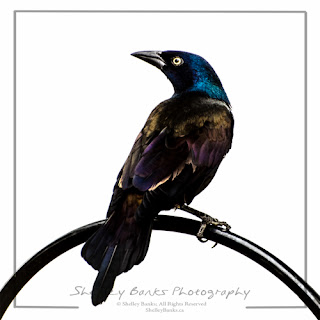 |
| One Common Grackle returned to the bird feeder. © SB |
The grackles scattered as soon as I eased the door open to take a photograph.
Most of these large black birds then seized space on the neighbours' yards, until a city bus belted down the street and drove the horde of chattering birds ahead of its wake.
Chattering. Yes, grackles are noisy. Imagine 60 creaky gates exchanging gossip at the back of a hardware store.
The sight of so many grackles, yellow eyes glittering, chilled me. What else would come to mind but The Birds?
But grackles are also highly sociable — all that cheerful clattering from trees and lawns.
And they are strangely beautiful, their feathers iridescent in the sun.
What is this? Common Grackle
Location: Front yard, Regina, Saskatchewan, Canada.
Photo date: August 22, 2012.
~~~~~











